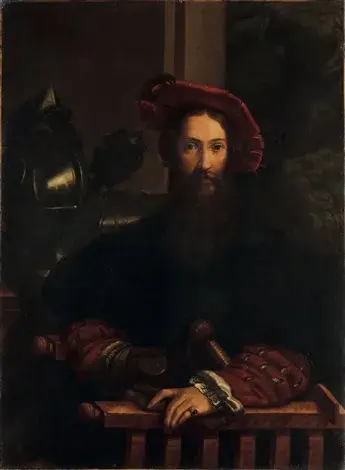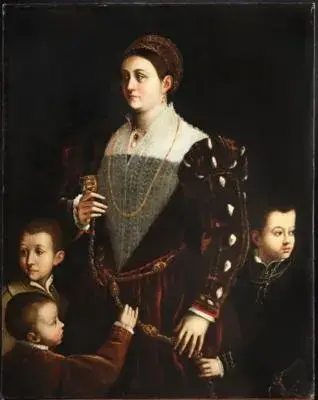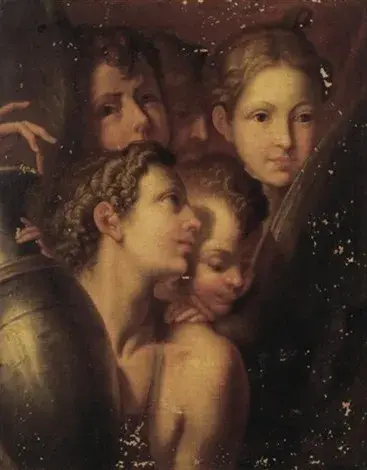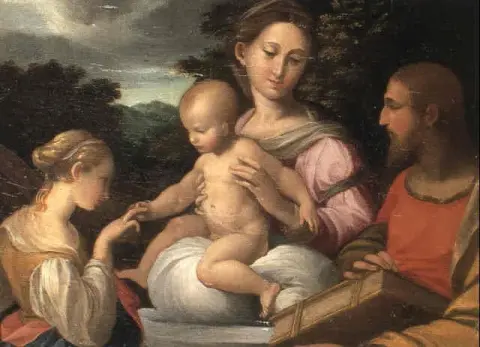

Hand painted reproductions of Parmigianino
Girolamo Francesco Maria Mazzola (Parmigianino): The Master of Mannerist Elegance
Girolamo Francesco Maria Mazzola (1503–1540), known as Parmigianino, was an Italian Mannerist painter whose graceful figures, elongated proportions, and exquisite use of sfumato set him apart as a master of the High Renaissance and early Mannerism. His work, blending Raphael’s harmony with Michelangelo’s dynamism, pushed the boundaries of classical beauty and inspired future generations of artists.
Early Life and Education
Born in Parma, Italy, in 1503, Parmigianino displayed prodigious talent from an early age. He was trained by his uncles, who were painters, before traveling to Rome in 1524. There, he studied the works of Raphael and Michelangelo, refining his elegant and elongated aesthetic.
His exposure to the grandeur of Roman art profoundly influenced his style, leading to a synthesis of classical balance and Mannerist sophistication. However, the Sack of Rome in 1527 forced him to flee to Bologna, where he continued to develop his distinctive approach.
Artistic Development and Style
Parmigianino’s art is characterized by elongated figures, refined gestures, and a dreamlike quality. His masterpiece, Madonna with the Long Neck, exemplifies this aesthetic, with its ethereal Virgin Mary, exaggerated proportions, and soft, flowing drapery.
He was also a skilled portraitist, as seen in Self-Portrait in a Convex Mirror, where he demonstrated his technical prowess and fascination with perspective. His use of light, delicate color transitions, and graceful contours distinguished him from his contemporaries.
Themes and Significance
Parmigianino’s paintings often explore themes of beauty, refinement, and divine elegance. His approach broke away from the idealized naturalism of the High Renaissance, instead embracing a more stylized and sophisticated aesthetic. This made him a key figure in the evolution of Mannerism, influencing artists such as Bronzino and El Greco.
Beyond painting, Parmigianino was a pioneer in printmaking, particularly in etching, where his innovative techniques expanded the possibilities of the medium.
Achievements and Influence
Despite his short life, Parmigianino left an enduring legacy. His paintings redefined artistic conventions, introducing a heightened sense of elegance and movement. His influence extended beyond Italy, shaping the development of European art well into the Baroque period.
Although he died at just 37, his work remains a cornerstone of Mannerist painting, admired for its beauty, technical mastery, and innovative compositions.
Legacy
Parmigianino’s masterpieces are housed in renowned museums such as the Uffizi Gallery in Florence and the Kunsthistorisches Museum in Vienna. His contribution to art history endures, bridging the gap between the harmonious idealism of the Renaissance and the expressive stylization of Mannerism.
Where to Find Reproductions of Parmigianino’s Art
For those captivated by the elegance of Parmigianino’s paintings, high-quality reproductions are available through POD (Painting On Demand). His works bring a timeless sophistication to any art collection.
Parmigianino’s artistic brilliance, with its fusion of grace, innovation, and refinement, continues to inspire and mesmerize, securing his place among the great masters of Italian art.
Imagine owning an original work of art by Parmigianino, one of the greatest artists in history. At POD we offer you the opportunity to make this dream come true. We reproduce Parmigianino's works down to the smallest detail, so you can enjoy them in your own home.
Our reproductions are made by experienced artists who use the best materials and techniques. We are dedicated to providing you with the highest quality works of art, which will bring joy and inspiration to your family for generations.















































